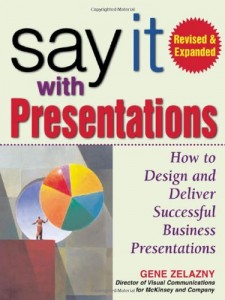
Gene Zelazny
4.0 out of 5 stars Fundamentals Most Ignore A Bit Too Generic, October 6, 2013
I was lent this book by a colleague. Here is some context for my appreciation of the book:
01 The Chairman of the Joint Chiefs of Staff (C/JCS) once BANNED all powerpoint presentations, for two reasons. First, because they had become “death by powerpoint” monstrocities in which intellectually limited people tried to substitute technology for thinking and color for precision of thought; and second, because more often than not, something would go wrong with the computer and the briefing officer would be found to be empty-headed. Too often (and I include myself) powerpoint presentations have been an aid for the BRIEFER, rather than a visual map for the DECISION-MAKER.
02 Presentations as most understand them are didactic tools (I talk you listen) instead of socractic tools (I spark, you engage, we create new understanding). Yes, one good visual can equal 10,000 words, but every visual past one radically loses value in a downward spiral. Less is more.
Presentations are not charts — they are different, a point the author addresses by publishing a separate book, The Say It With Charts Complete Toolkit, Cd-Rom.
Presentations are also not visualizations, an area where Edward Tufts is a leading light, a mind whose two books below I highly recommend:
Envisioning Information
The Visual Display of Quantitative Information
Presentations are a tool for thinking and a tool for inspiring human engagement, on this point I have been guided by Howard Rheingold and his books and web blogging, see for instance, Tools for Thought: The History and Future of Mind-Expanding Technology from the 1980's and the more recent Mind Amplifier: Can Our Digital Tools Make Us Smarter? (Kindle Single).
Put as simply as I can, a presentation is a tool for thinking — one third of the value is in the thinking and doodling and exploration of alternative paths leading to the presentation; one third of the value is in the final product that can inspire others on its own and as a tool, and the last third of the value, almost never achieved, is in the reaction, engagement, inspiration, and collective intelligence that the presentation might elicit.

